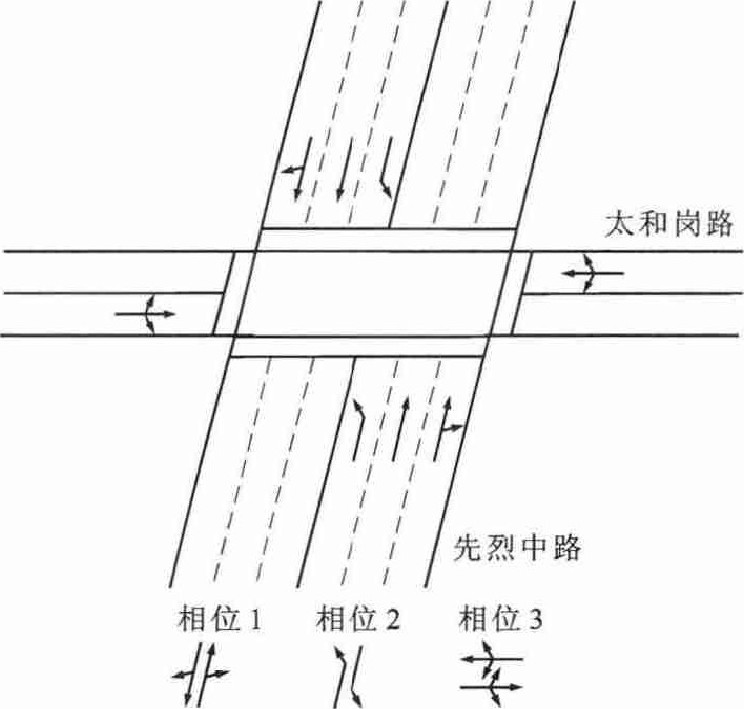TOD optimal control method of urban traffic based on clustering analysis
-
摘要: 为了降低环形线圈车辆检测器故障率, 基于指数平滑异同移动平均线法对缺失历史数据进行修补, 运用Ward最小方差法对历史交通流量数据进行聚类分析, 以改进立方群准则作为聚类终止条件, 确定TOD多方案控制的最优方案数和最佳切换时刻, 利用交通信号配时优化软件Synchro对TOD优化控制方法进行仿真验证。验证结果表明: 优化控制方法能够提供更精细的TOD控制方案, 更能体现对实际交通需求波动的响应, 优化后控制方案的车均延误减少率平均为11.90%, 其中早高峰前时段的车均延误减少率为20.27%, 晚低峰、晚高峰和早高峰的车均延误减少率分别为12.99%、8.07%、6.25%。Abstract: To overcome the high failure rate of circular loop vehicle detector in real road, the loss historical data were mended by using moving average convergence divergence method.The historical traffic flow data were clustered by using Ward least square method.A clustering terminal condition was proposed to determine the optimal control plan number and switch time of TOD multi-schedule control based on the modified cubic clustering criterion.TOD optimal control method was simulated and verified by using signal timing optimization software Synchro.Verification result indicates that TOD optimal control method can provide more detailed TOD control plan, which can also respond the fluctuation of real traffic demand.The average decrement rate of each vehicle delay based on the optimal control method is 11.9%, in which the decrement rate in pre-morning peak period is 20.27%, and the values in evening low peak period, evening peak period and morning peak period are 12.99%, 8.07% and 6.25%, respectively.
-
表 1 现状控制方案的运行时段
Table 1. Operation periods of current control plans

表 2 信号配时方案
Table 2. Signal timing plans

表 3 历史交通流量数据的聚类过程Fig.3 Clustering procedure of historical traffic flow data

表 4 聚类后控制方案的运行时段
Table 4. Operation periods of control plans after clustering

表 5 聚类前后控制方案的车均延误
Table 5. Average each vehicle delays of control plans before and after clustering

-
[1] KLEIN L A, MILLS M K, GIBSON D R P. Traffic Detector Handbook[M]. Washington DC: Federal Highway Administration, 2006. [2] 麻育平, 王磊. 交通信号控制系统中TOD优化方法浅析[J]. 道路交通管理, 2012 (6): 48-50. https://www.cnki.com.cn/Article/CJFDTOTAL-DLJG201206029.htmMA Yu-ping, WANG Lei. Analysis of TOD optimization method in traffic signal control system[J]. Road Traffic Management, 2012 (6): 48-50. (in Chinese). https://www.cnki.com.cn/Article/CJFDTOTAL-DLJG201206029.htm [3] PAPAGEORGIOU M. A new approach to time-of-day control based on a dynamic freeway traffic model[J]. Transportation Research Part B: Methodological, 1980, 14 (4): 349-360. doi: 10.1016/0191-2615(80)90015-6 [4] KREER J B. Factors affecting the relative performance of traffic responsive and time-of-day traffic signal control[J]. Transportation Research, 1976, 10 (2): 75-81. doi: 10.1016/0041-1647(76)90043-5 [5] HAUSER T A, SCHERER W T. Data mining tools for realtime traffic signal decision support and maintenance[C]∥IEEE. 2001 IEEE International Conference on Systems, Man, and Cybernetics. Tucson: IEEE, 2001: 1471-1477. [6] PARK B, LEE D H, YUN I. Enhancement of time of day based traffic signal control[C]∥IEEE. 2003IEEE International Conference on Systems, Man, and Cybernetics. Manchester: IEEE, 2003: 3619-3624. [7] PARK B, SANTRA P, YUN I, et al. Optimization of timeof-day breakpoints for better traffic signal control[J]. Transportation Research Record, 2004 (1867): 217-223. https://trid.trb.org/view/741281 [8] PARK B, LEE J. A procedure for determining time-of-day break points for coordinated actuated traffic signal systems[J]. KSCE Journal of Civil Engineering, 2008, 12 (1): 37-44. doi: 10.1007/s12205-008-8037-3 [9] LEE J, KIM J, PARK B. A genetic algorithm-based procedure for determining optimal time-of-day break points for coordinated actuated traffic signal systems[J]. KSCE Journal of Civil Engineering, 2011, 15 (1): 197-203. doi: 10.1007/s12205-011-1093-0 [10] ZHOU Zhan-hong, CAI Ming. Intersection signal control multi-objective optimization based on genetic algorithm[J]. Journal of Traffic and Transportation Engineering: English Edition, 2014, 1 (2): 153-158. doi: 10.1016/S2095-7564(15)30100-8 [11] WANG Xiao-dong, COTTRELL W, MU Si-chun. Using K-means clustering to identify time-of-day break points for traffic signal timing plans[C]∥IEEE. Proceedings of the 8 th International IEEE Conference on Intelligent Transportation Systems. Vienna: IEEE, 2005: 519-524. [12] RATROUT N T. Subtractive clustering-based K-means technique for determining optimum time-of-day breakpoints[J]. Journal of Computing in Civil Engineering, 2010, 25 (5): 380-387. [13] YANG Jun, YANG Yang. Optimization of time of day break points of intersection using cluster method[J]. International Journal of Advancements in Computing Technology, 2013, 5 (6): 479-487. doi: 10.4156/ijact.vol5.issue6.56 [14] GUO Rui, ZHANG Yu. Cluster analysis-based procedure to identify time-of-day breakpoints for coordinated semi-actuated traffic signal system[C]∥TRB. Transportation Research Board 91 st Annual Meeting. Washington DC: TRB, 2012: 1-18. [15] GUO Rui, ZHANG Yu. Identifying time-of-day breakpoints based on nonintrusive data collection platforms[J]. Journal of Intelligent Transportation Systems: Technology, Planning, and Operations, 2014, 18 (2): 164-174. doi: 10.1080/15472450.2013.802151 [16] QU Xiao-bo, ZHANG Jin, WANG Shuai-an, et al. Modelling follow up time at a single-lane roundabout[J]. Journal of Traffic and Transportation Engineering: English Edition, 2014, 1 (2): 97-102. doi: 10.1016/S2095-7564(15)30093-3 [17] BALKE K N, RAO K S, HUSTED M. Incorporating the effects of signal transition in the selection of timing plans in traffic responsive signal systems[R]. Austin: Texas A & M University, 1998. [18] SHELBY S G, BULLOCK D M, GETTMAN D. Transition methods in traffic signal control[J]. Transportation Research Record, 2006 (1978): 130-140. https://trid.trb.org/view/777654 [19] 栗红强, 陆化普, 刘强. 城市交通线控多时段配时方案过渡算法研究[J]. 武汉理工大学学报: 交通科学与工程版, 2008, 32 (5): 779-781, 852. doi: 10.3963/j.issn.2095-3844.2008.05.002LI Hong-qiang, LU Hua-pu, LIU Qiang. Research on transition algorithms for timing plans of arterial time in-day traffic control[J]. Journal of Wuhan University of Technology: Transportation Science and Engineering, 2008, 32 (5): 779-781, 852. (in Chinese). doi: 10.3963/j.issn.2095-3844.2008.05.002 [20] 卢凯, 徐建闽, 郑淑鉴, 等. 交通信号协调控制方案过渡优化算法[J]. 交通运输工程学报, 2012, 12 (6): 97-103. http://transport.chd.edu.cn/article/id/201206015LU Kai, XU Jian-min, ZHENG Shu-jian, et al. Optimization algorithm of coordinated control scheme transition of traffic signal[J]. Journal of Traffic and Transportation Engineering, 2012, 12 (6): 97-103. (in Chinese). http://transport.chd.edu.cn/article/id/201206015 [21] WANG Jian-qiang, NIU Hui-min. Graded-information feedback strategy in two-route systems under ATIS[J]. Journal of Traffic and Transportation Engineering: English Edition, 2014, 1 (2): 138-145. doi: 10.1016/S2095-7564(15)30098-2 [22] SARLE W S. Cubic clustering criterion[R]. Cary: SAS Institute Inc., 1983. [23] LIAO Fei-xiong, ARENTZE T, TIMMERMANS H. Multi-state supernetworks: recent progress and prospects[J]. Journal of Traffic and Transportation Engineering: English Edition, 2014, 1 (1): 13-27. doi: 10.1016/S2095-7564(15)30085-4 [24] 姚佼. 基于车辆行驶数据的交叉口交通控制机制研究[D]. 上海: 同济大学, 2011.YAO Jiao. Study on vehicle probe data based traffic control mechanism at isolated intersection[D]. Shanghai: Tongji University, 2011. (in Chinese). -





 下载:
下载:






